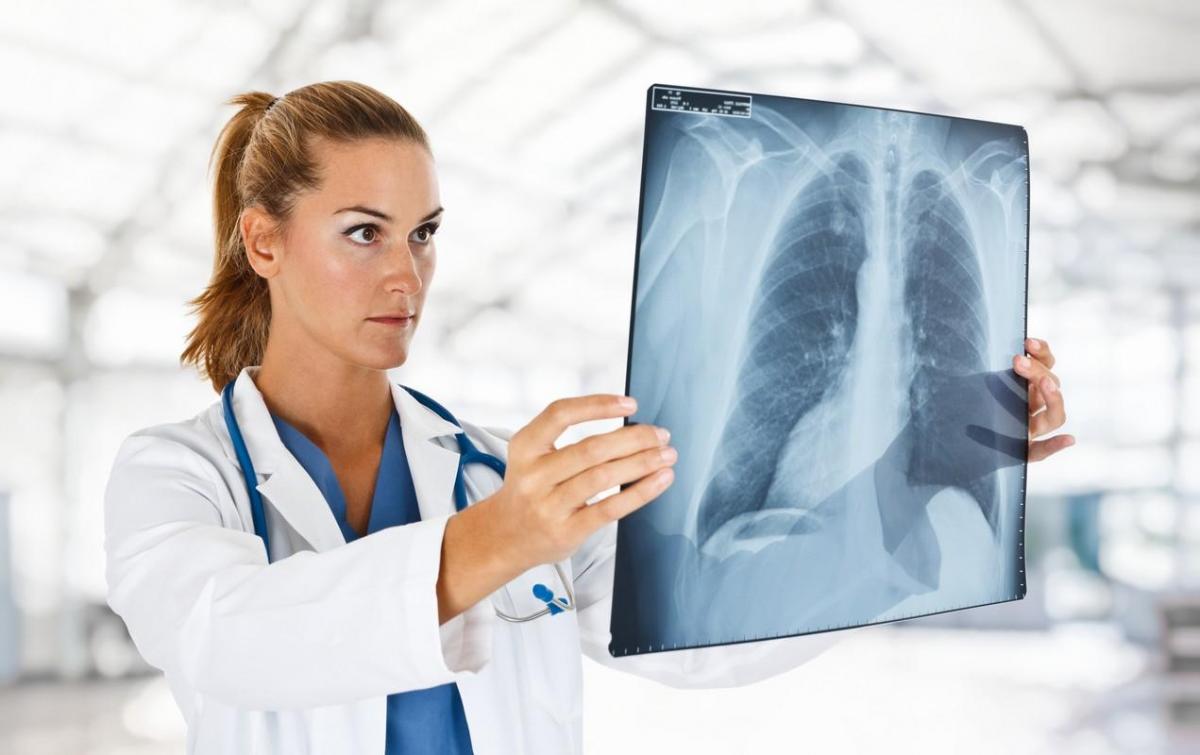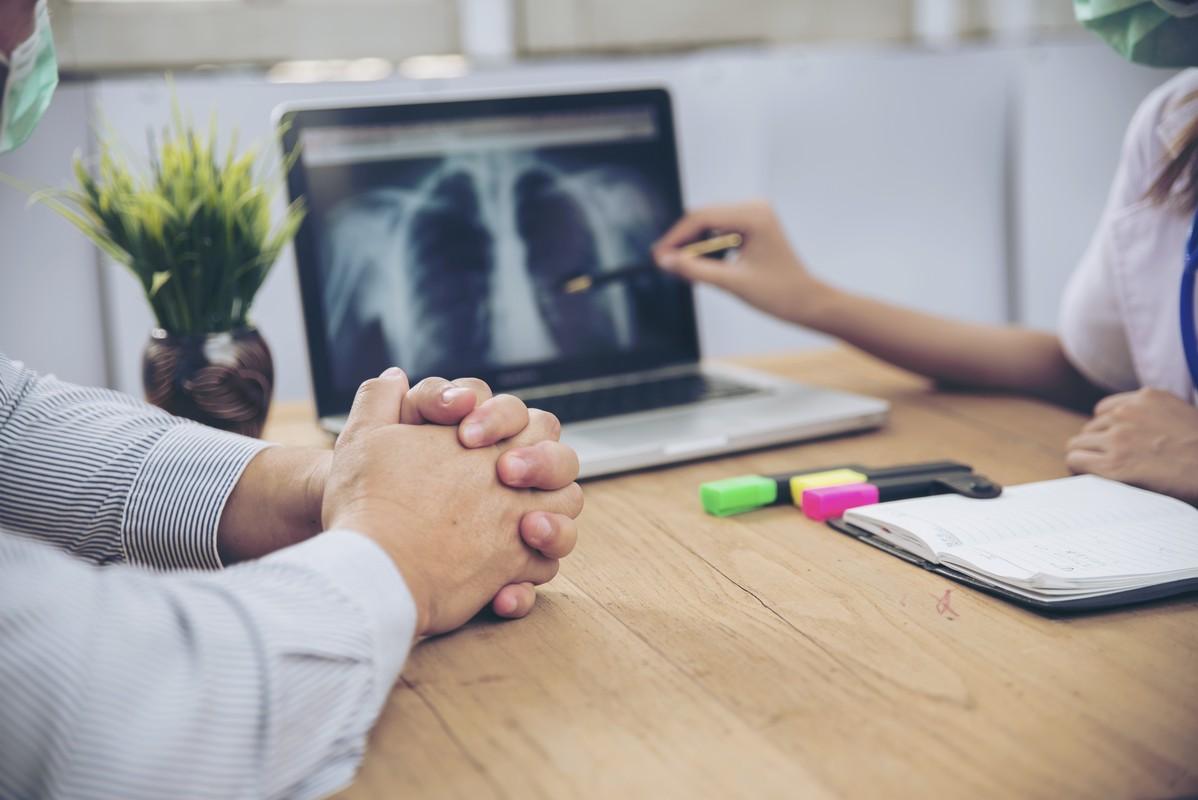
What Is Non–Small-Cell Lung Cancer?
Lung cancer is a condition where abnormal cells begin to grow out of control. There are two main types of lung cancer: small-cell lung cancer makes up 10-15% of cases, and non–small-cell lung cancer (NSCLC), which is much more common, makes up 80-85%.1 A pulmonary specialist or oncologist will determine which type of cancer is present by examining the cancerous cells under a microscope.
Symptoms of both types are very similar and may include:1
- Wheezing and a persistent cough
- Coughing up blood
- Difficulty swallowing
- Shortness of breath
- Chest pain
- Appetite loss and fatigue
- Swelling of the face and neck
What Are the Sub-Types of Non–Small-Cell Lung Cancer?
Respiratory specialists divide the non–small-cell types of lung cancer into several subtypes:
- Adenocarcinoma -begins in cells that secrete mucus in the lungs and accounts for approximately 40% of lung cancers. It tends to grow more slowly than other types and is often identified in its early stages.1
- Squamous-cell carcinoma- starts in squamous cells, which line the airways of the lungs. 25-30% of lung cancers are this type.1
- Large-cell carcinoma- Also called undifferentiated carcinoma, this subtype is seen 10-15% of the time. It tends to grow and spread fairly rapidly, and it might be in any part of the lung.1
While any type of lung cancer is a serious challenge, this disease is survivable in many cases with the earlier diagnosis and advanced treatment options now available.
How Is Non–Small-Cell Lung Cancer Diagnosed?
The early symptoms of non–small-cell lung cancer may be noticed by an asthma specialist or another health care professional. If you are showing symptoms, it may be wise to make an appointment with a pulmonary specialist rather than searching for a “primary care doctor near me.”
These types of tests will identify exactly which type of lung cancer is present and help determine early treatment options to improve outcomes:3
- Chest x-rays will help locate fluid buildup, scar tissue, or tumors.
- Blood and urine tests will help eliminate other potential causes of symptoms.
- Sputum tests can give clues to what types of cells are being coughed up and why.
- Bronchoscopy allows doctors to view the airways with a tiny camera and view problem areas.
- CT scans will provide detailed images of the lungs and identify in three dimensions the location, size, and shape of tumors.
- Biopsy provides a small sample of the suspicious cells for microscopic examination, which will yield a final determination of whether a growth is cancer and of what type.
Who Is at Risk for NSCLC?

While not every individual who develops lung cancer has an identified cause or risk factor, there are clear links between certain factors and the abnormal cell growth that causes this disease.
Causes of non–small-cell lung cancer include:2
- Smoking cigarettes or exposure to secondhand cigarette smoke
- Exposure to smoke, diesel exhaust, or pollutants in the environment
- Contact with sources of radiation or radon
- Exposure to substances such as asbestos, arsenic, nickel, chromium, tar, or soot
- Being diagnosed with HIV
- Having a family history of lung cancer
- Genetic changes which may be inherited or acquired from exposure to cancer-causing substances
The longer a person lives, the more likely it is that they will develop some type of cancer. While growing older is a natural process, age can be considered a risk factor in developing this disease.
Can the Risk of Lung Cancer Be Reduced?
Because some lung cancers develop without identified risk factors, prevention efforts center around avoiding the known causes. Even after diagnosis, taking these steps will support cancer treatment:
- Eliminate all exposure to cigarette smoke.
- Install radon detectors and filter air in the home.
- Avoid all exposure to cancer-causing chemicals at work and at home.
- Eat a healthy diet rich in fruits, vegetables, and natural antioxidants.
Non–Small-Cell Lung Cancer Stages
As part of diagnosis and to guide treatment options, NSCLC is assigned a “stage” which is a clearly defined technical way to describe how far cancer has spread. This allows your medical team to track treatment success by measurable means.
The stages of non–small-cell lung cancer are:
- Occult or Hidden: Abnormal cells have been found in sputum or other evidence of cancer exists, but the cells have not been found by imaging.
- Stage 0: Abnormal lung cancer cells have been found in the body.
- Stage 1: Cancer cells have formed but have not spread to nearby lymph nodes.
- Stage 2: Cancer cells have formed a larger tumor and/or have spread to at least one lymph node.
- Stage 3a: This indicates that cancer cells are present in the lymph nodes on the same side of the chest as the tumor. The cells may have spread to other tissues, including chest wall or heart membranes.
- Stage 3b: In this stage, the lymph nodes on the opposite side of the chest or above the collarbone are involved, and cancer may have spread to nearby tissues in the throat and chest.
- Stage 4: At this stage, the cancer cells have spread to numerous lymph nodes and may be in one or both lungs, surrounding tissues and organs, or in distant parts of the body.
Treatment Options for Non–Small-Cell Lung Cancer
Choosing the best lung cancer treatment plan for you or your loved one will be based on your doctors’ evaluation of the unique symptoms, the subtype of NSCLC, and the current stage.
One or more of these treatment options may be part of a comprehensive treatment plan to reduce symptoms, kill cancer cells, and stop their ability to reproduce:3
- Surgery removes tumors and cell groups from the lungs or lymph nodes. Your surgeon will remove as many cancer cells as is feasible while preserving as much lung tissue as possible. Only so much lung tissue can be removed without impacting breathing ability.
- Endoscopic stents may be inserted to keep airways open if tumors are causing them to close.
- Chemotherapy is used to directly treat cancer cells which are dividing rapidly, to slow or stop that rapid growth.
- Radiation treatments kill cancer cells that are too small or widespread to be targeted by other methods.
Seeking Comprehensive Treatment from an Integrated Team of Specialists

If you or someone you care about has been diagnosed with lung cancer or has concerns because they’re experiencing symptoms like chest pain or shortness of breath , seeking a medical support team that specializes in the latest diagnostic and treatment options available will provide the help you need at the earliest possible stage.
Our team at Crystal Run Healthcare in New York shares compassion and their expertise with every patient and our community.
Seeing your doctor or pulmonary specialist on a regular basis for cancer screenings is one of the best ways to maintain health and recognize symptoms early. Your fight against cancer starts now by taking preventative measures and getting the necessary screenings. Our multi-disciplinary team at Crystal Run is ready to support and guide you, so don’t wait to take action. Contact us today to schedule an appointment.
Sources:

 Optum Radiology at Crystal Run Healthcare
Optum Radiology at Crystal Run Healthcare Request medical records online
Request medical records online